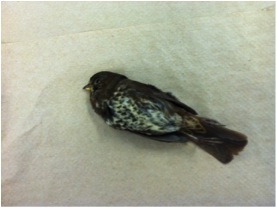
Photo by L. Wilson
Something that I hear many guests exclaim as they watch staff and volunteers from the Ornithology and Mammalogy department prepare study skins is, “did they kill that?” While going into the field on collecting trips was the common way for museums to obtain their specimens in the past, this is no longer common in our department. We rely heavily on the donation of dead animals by private individuals and organizations; it can be something that your cat brought in, something that was hit by a car, washed up on the beach – we take it all!
One of the birds I worked on today was a Fox Sparrow (above) given to us by Point Reyes Bird Observatory (PRBO). This bird was found dead on a porch, likely due to hitting a window. I’ve had guests mention to me that they’ve never heard of a bird dying this way, but it’s actually more common than you might think. Often, birds only see the reflection of the sky and plants in the glass and assume it’s safe to fly towards it. Sometimes they simply bounce off and fly away, but often they can hit hard enough to instantly kill themselves or sustain a fatal injury. Have you noticed that the windows on our main floors have silhouettes of birds of prey on them? Because the academy has such large windows, we have to be responsible about the possibility of killing birds. These silhouettes of hawks and other predators, along with shades drawn down over the windows, keep other birds from flying towards the glass.

Photo by L. Wilson
If you want to minimize the chance of birds hitting your windows at home, hang sheer curtains or keep blinds and shutters partially closed. However, if you do find a dead bird near your house, bring it by the reception desk here at the Academy and it will forever be a part of our collection!
Laura Wilson
Curatorial Assistant & Specimen Preparator
Department of Ornithology & Mammalogy